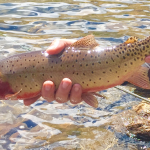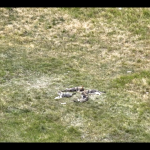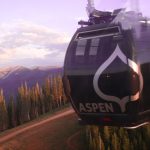Pitkin County ‘in trouble until the snow falls’
Extreme conditions, wildfire risk have become the new normal

Beau Toepfer/The Aspen Times
Pitkin County has seen the eighth driest season on record in 131 years this January to June, according to the National Oceanic and Atmospheric Administration.
Because of this, wildfire fuels are exceptionally prone to burn.
Jake Andersen, the fire chief for the Aspen Fire Protection District, confirmed the extreme drought in Pitkin and Gunnison counties has led to stress on the landscape, causing plants to go into dormancy early and leaves to change colors as early as last month.
“Look around, it looks like fall, but it’s not,” Andersen said. “Many of our vegetation types that are typically even somewhat resistant to fire are now becoming available because they’re going into dormancy early.”
The only other time he has seen leaves turning early was in August 2020 — the year of the Grizzly Creek Fire and three of the largest wildfires in Colorado’s recorded history.
According to Birch Barron, the director of emergency management for Eagle County, these drought conditions have made it so even small sparks can cause a fire, and almost all small fire starts will quickly escalate to a large wildfire. Compared to previous years when there was more moisture, this season is one of the most extreme for fire danger.
“(It’s the) difference between putting a big, thick, wet log on your campfire versus a piece of newspaper soaked in gasoline,” Barron said.
Many fires are growing from zero to 500 acres within about an hour and a half, said Devon Blanchard, a wildland firefighter with Carbondale & Rural Fire Protection District, unless they can be quickly engaged by firefighters. The silver lining is that firefighters can conduct blackburn operations easily with dry fuels, as well, where they ignite fire towards an encroaching wildfire to create more distance between the wildfire and available fuels.
Blanchard noted many fires are still doubling in size every 30-40 minutes.
“Our lack of snow over the last three years or four years has made everything a lot drier, actually, comparable to California,” he said. “We’re kind of getting to that point where everything can catch on fire without really having to do anything.”
According to Andersen, the recent fires in the Roaring Fork Valley, namely the Snowmass Creek Fire and the Coulter Creek Fire, were caught effectively because they were burning with unfavorable conditions and because of how quickly large resources were allocated to the fires. The Snowmass Creek Fire had no wind, and the Coulter Creek Fire had favorable winds and a downhill slope.
Despite this, fuels that typically need to be “preheated,” like oak brush, were burning completely, and fires were burning against conditions that normally slow them down significantly.
“In most years, (oak brush) doesn’t burn very well — a lot of times it burns the dead leaves underneath it, and the canopy becomes a problem because it gets preheated,” Andersen said. “Right now, we’re seeing full consumption of many of these fuel types, meaning that from root to leaf, they’re all available to burn. That’s not necessarily common, but it’s becoming more and more common.”
Even typically fire-resistant trees, like aspens, that firefighters will use as natural barriers are burning easily, he added. To stop fires, firefighters will use a mix of natural barriers — like fire-resistant tree groves or ridgelines — as well as ground and aerial resources. He said the maximum flamelength a wildland firefighter can engage with a hand tool is four feet, which is why aerial resources are so important.
“With those really large, really hot wildfires, even the air support becomes limited in its effectiveness,” Barron said. “If we are … in conditions like we were earlier in this year, where those fires are moving slow and burning at a lower temperature, then that air support and those ground firefighters have a lot more opportunity to successfully remove the energy from the fire and slow it down and stop that fire from spreading before it hits things that we care about.”
But he noted if fires are burning “hot and fast” through current conditions, even maximum air support might not be effective.
“It is so important to catch these things small,” Andersen said. “If you were to look at this from a performance indicator of effectiveness, the cost of suppression per acre should actually go up, meaning that we are putting our money where it matters.”
According to Scott Thompson, the fire chief for Roaring Fork Fire Rescue, these extreme conditions could persist until the first snowfall. In order to improve moisture levels enough to stabilize the fire danger, there would need to be weeks of steady rain plus time for the vegetation to absorb that moisture. He also noted that exceptionally dry leaf litter in the fall could continue the fire season longer than normal.
“I think we’re going to be in trouble until the snow falls,” Thompson said. “I hope I’m wrong, but it could happen.”
Because of the rapid growth of wildfires, Barron urges residents to be prepared for a quick evacuation. Wildfires have been growing quickly, and there may not be very much time to evacuate. He also noted how important it is to follow fire restrictions and be exceptionally cautious while recreating.
“Now is an excellent time to review your emergency plans with your family and be ready,” he said. “Make sure you’re prepared to leave your home quickly because if we do have a new fire start, there’s a high potential that it could grow and expand quicker than ever before.”










